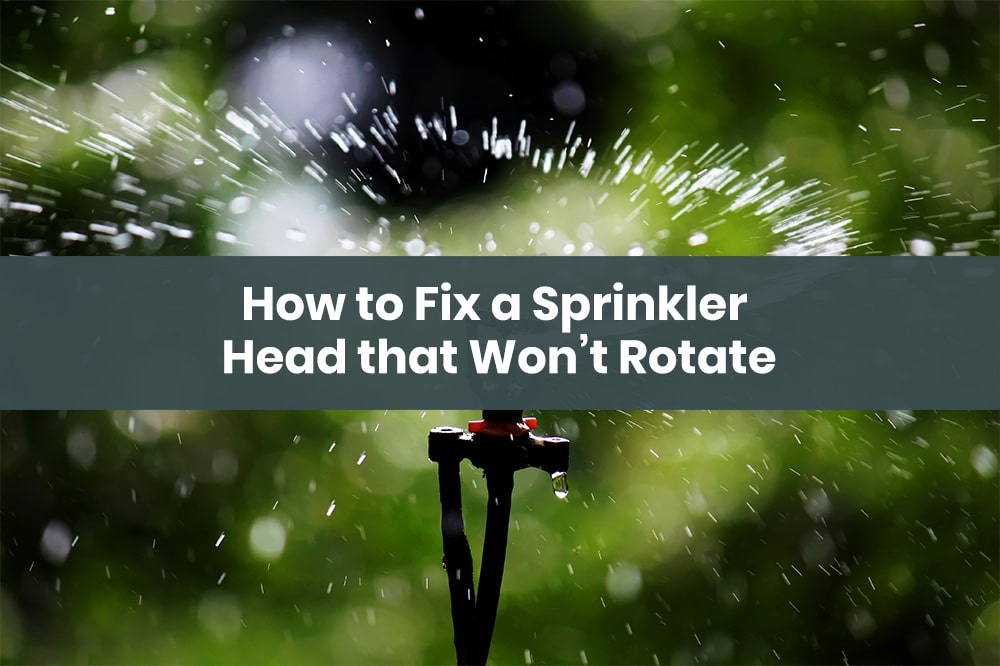A rotating sprinkler head is an excellent tool for watering your yards, gardens, lawns, and more. However, while they might be excellent watering tools, they are prone to damage, because they have several moving components.
You should know that rotating sprinklers leverage water pressure to move several small gears in the body of the sprinkler. Thus, any complications such as debris can easily lead to clogging, which will, in turn, damage the sprinkler entirely.
Keeping track of the causes of these complications is vital for the repair process.

Read Next
Common Causes of Sprinkler Heads that Won’t Rotate
The following are some of the common causes for a sprinkler head that won’t rotate. They include:
Clogged Filters
Most sprinklers feature a small plastic filter for debris. You can access the filter by twisting the nozzle, and it also depends on the type of sprinkler you have available.
Plus, the plastic screen works to filter various types of debris that might have adverse effects on the sprinkler's performance. If the sprinkler gets compromised with dirt, it might fail to distribute water as required. Therefore, maintaining the functionality of the filter should be imperative.
Damage to the Sprinkler Heads
Made using a unique combination of materials such as brass and plastic, sprinkler heads are not often easy to maintain. These are components that can bend, break or crease when they are exposed to high-impact forces.
For instance, such as when you run over it with your car, the increased force levels can easily compromise the internal components. Thus, it becomes a smashed sprinkler that won't pop up as required, which can cause complications with the water coverage levels.
Old or Frail Supply Tubes
Sprinklers also feature rotating heads that function under pressure to help raise the nozzle for the distribution of water. Any small particles such as dirt or sand can easily get lodged in the interior supply tube or the exterior section of the sprinkler body.
When this occurs, friction can accumulate over time and have adverse side effects on the supply tube. In the end, such an issue might cause the head to stop moving because friction compromises the functionality of the tubes. When this occurs, you might have to replace the entire sprinkler.
Remedies
When the water pressure is low, an insufficient amount of water might travel through the sprinkler head. Such an issue will cause the sprinkler head to stop functioning. The most convenient approach to increase the pressure levels on one of the heads would be to adjust the irrigation zone sizes.
Using this approach for water management will reduce the number of heads that function simultaneously, which will correct the flow of water. Plus, using a massive backflow preventer in the water can go a long way in helping to regulate the flow of water.

Fixing a Damaged Sprinkler Head
Fixing a sprinkler head is easy when you have the right information and help. Plus, you also need a good toolbox to complete the process.
The most common cause of sprinkler head failure would be damage to the internal components. The common signs of broken components include damaged plastic casings around the head or damage to the spray nozzle.
The other signs that you have to repair the sprinkler include an uncontrolled flow of water, or a sprinkler head that fails to pop up as required.
If the sprinkler heads are damaged, consider performing a replacement process. That said, if you don’t come across any sign of damage, then try to clean the internal components of any debris. Plus, you can also adjust the spray pattern for your convenience.
Adjusting the Spray Head Pattern of a Sprinkler
The range of sprinkler head types is diverse, and each in terms of its features and functionalities. The common ones you will find on the sprinkler accessory market include pop-ups, pulsating heads, rotors, and more.
Even if some of these procedures are similar, each of them is unique. You may also need an excellent DIY toolbox if you want to correct this problem conveniently. The steps to consider include:
- If you have a stationary sprinkler head, locate the spray radius screw that sits on the nozzle section. Plus, you have to adjust it as required to direct the water spray to your chosen space. Rotating it clockwise is also beneficial for regulating the spray of water, and ensuring it does not produce excessive levels of water.
- If you have a rotor sprinkler, you may have to customize the radius and spray arc for the best results. Get a set screw and use it to position the rotor sprinkler nozzle in the right place. That said, the instructions for these tools vary in relation to specific brands, so you may have to get the appropriate instructions for the same.
- The pop-up sprinkler heads are popular and easy to adjust for your water supply purposes. However, you may have to customize the sprinkler as it functions. When the sprinkler is running, get a flathead screwdriver and use it to adjust the screw that sits on the nozzle section. Plus, if you want to improve the length of the spray, then adjust the screw counterclockwise. The opposite applies when you want to reduce these levels.
- You don’t need any special tools for customizing the pulsating sprinkler heads. However, before you start, ensure you check the heads for any damage, and determine the sections you want the water to reach. The next step is to customize the speed of water output by customizing the tabs that sit on the nozzle. Remember the rotary types can turn full circle, and you may have to calibrate their turning as required.
Final Thoughts
Being able to regulate the use of water is a critical practice, especially in the modern-day, where people seek sustainable solutions. In this guide, we have information on how to fix a sprinkler head that won’t rotate.
Usually, it fails to turn because debris gets to the internal components, or when it's damaged as well. You can fix such an issue DIY when you have the right tools and information. However, you can always still call a professional service – which means you have to wait and pay for their services. Fixing the sprinkler head can therefore be an excellent way to save cash on repair services or costs.





Comments
No Comments